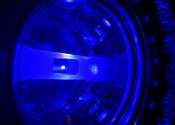An atomic clock is a type of clock that uses an atomic resonance frequency standard as its timekeeping element. They are the most accurate time and frequency standards known, and are used as primary standards for international time distribution services, and to control the frequency of television broadcasts and GPS satellite signals.
Atomic clocks do not use radioactivity, but rather the precise microwave signal that electrons in atoms emit when they change energy levels. Early atomic clocks were masers with attached equipment. Currently the most accurate atomic clocks are based on absorption spectroscopy of cold atoms in atomic fountains such as the NIST-F1.
National standards agencies maintain an accuracy of 10-9 seconds per day (approximately 1 part in 1014), and a precision set by the radio transmitter pumping the maser. The clocks maintain a continuous and stable time scale, International Atomic Time (TAI). For civil time, another time scale is disseminated, Coordinated Universal Time (UTC). UTC is derived from TAI, but synchronized, by using leap seconds, to UT1, which is based on actual rotations of the earth with respect to the mean sun.









